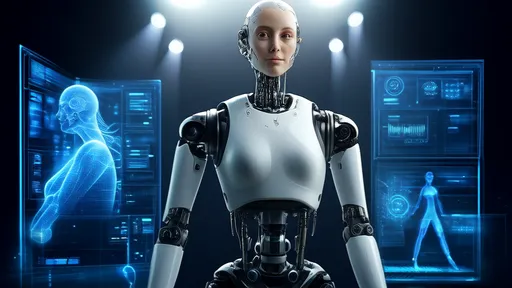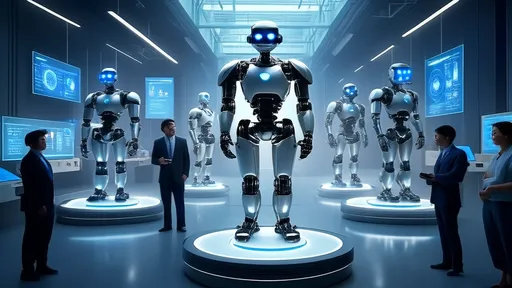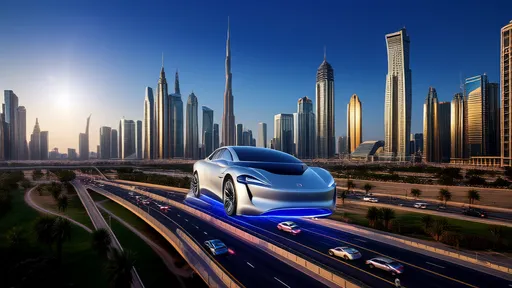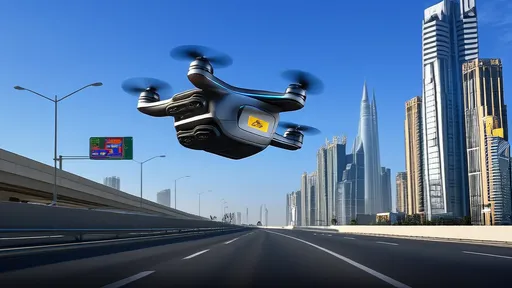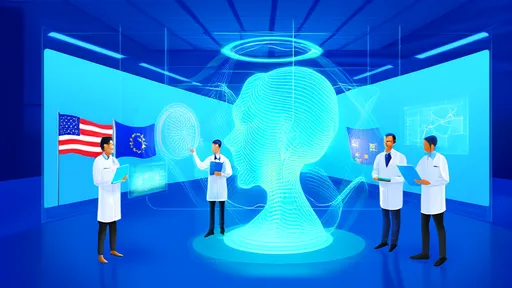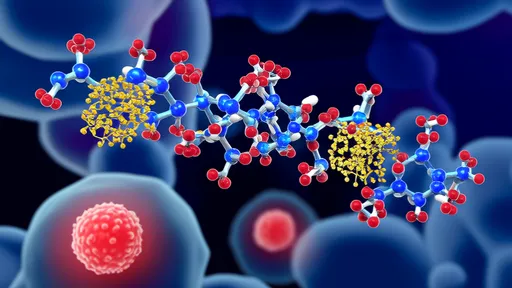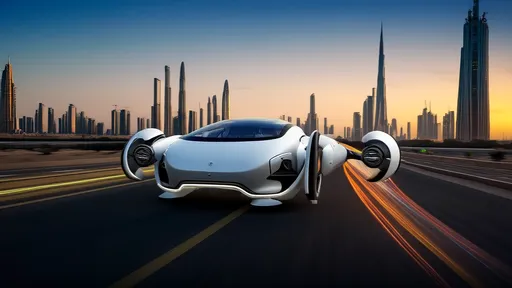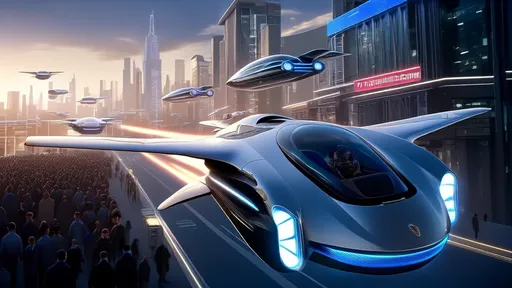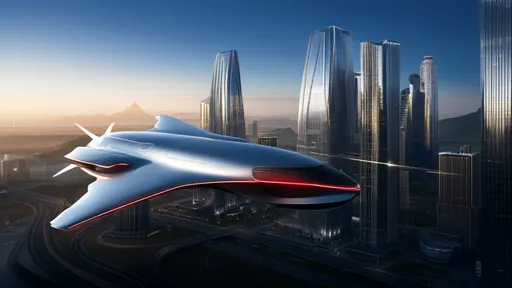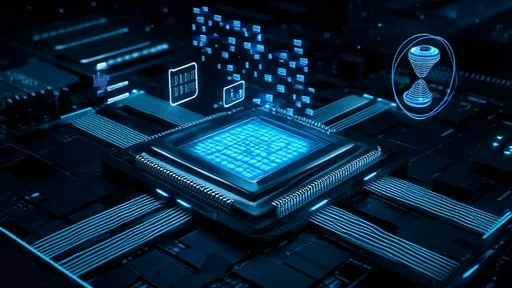The once-fantastical vision of humanoid robots, long confined to the pages of science fiction and the silver screen, is steadily materializing into a tangible engineering reality. This evolution is not the result of a single, monumental breakthrough but rather a profound and intricate symphony of advancements across a multitude of scientific and engineering disciplines. The quest to create machines that not only look but also move, perceive, and interact with the fluidity and adaptability of humans represents one of the most ambitious technological endeavors of our time. It is a grand convergence, where progress in artificial intelligence, materials science, mechanical engineering, and cognitive science coalesces to breathe life into metal and silicon, pushing the boundaries of biomimicry to unprecedented heights.
At the very core of a humanoid robot's physical presence lies its structural and actuation system—its skeleton and muscles. Early iterations were often rigid, jerky, and unmistakably mechanical. Today, the paradigm has shifted dramatically. Engineers are increasingly turning to advanced composite materials and novel actuator technologies to replicate the complex biomechanics of the human body. The use of carbon fiber composites and lightweight, high-strength alloys has enabled the creation of frames that are both incredibly strong and surprisingly light, a crucial factor for energy efficiency and dynamic movement. Simultaneously, the development of tendon-driven systems and advanced hydraulic or pneumatic actuators mimics the function of human muscles and tendons. These systems allow for a more nuanced and compliant application of force, enabling robots to perform delicate tasks like handling a fragile egg while also possessing the strength to lift heavy objects. This bio-inspired approach to mechanics is fundamental to achieving the graceful, energy-conserving gait and dexterous manipulation that characterize human movement.
While a sophisticated body is essential, it is the "brain" and "nervous system" that truly animate a humanoid robot. This is where the fields of artificial intelligence and sensor fusion come into play. Perceiving and understanding the environment is a non-negotiable prerequisite for meaningful interaction. Modern humanoids are equipped with a suite of sensors that would make any bio-engineer envious: high-resolution stereoscopic cameras for depth perception, LIDAR for precise 3D mapping, inertial measurement units (IMUs) for balance and orientation, and sophisticated microphones for auditory input. The real magic, however, happens in the computational layers that process this deluge of data. Through deep learning and complex neural networks, these systems can identify objects, recognize faces and gestures, and parse human speech in real-time. This sensory information is fused together to create a coherent and dynamic model of the world, allowing the robot to navigate a cluttered room, track a moving person, or understand a spoken command within its context.
The ultimate test of this integrated perception and intelligence is embodied in locomotion and manipulation. Walking on two legs is a deceptively complex feat of continuous balance and dynamic control. Researchers have moved beyond simple pre-programmed gait cycles, developing adaptive control algorithms that allow robots to adjust their stride, posture, and foot placement in real-time to navigate uneven terrain, recover from pushes, or climb stairs. This involves a constant, high-speed feedback loop between the joint sensors, IMUs, foot pressure sensors, and the central processing unit. Similarly, the challenge of manipulation—of giving a robot useful hands—is being addressed through a combination of mechanical design and AI. Multi-fingered, tactile-sensitive hands are being developed, capable of conforming to the shape of an object and gauging the appropriate grip force. Machine learning algorithms train these hands in simulation on thousands of virtual objects, teaching them complex in-hand manipulation skills, from twirling a pen to using a tool, transferring this learned dexterity to the physical world.
Perhaps the most critical frontier for humanoid robotics, and the one that will ultimately determine their integration into society, is human-robot interaction (HRI). A robot can be mechanically and computationally brilliant, but if it cannot communicate and collaborate with people effectively, its utility remains limited. This has spurred significant research into social AI and affective computing. The goal is to equip robots with the ability to understand and, to a certain extent, exhibit social cues. This includes not just processing language, but also understanding its subtleties, such as sarcasm or intent, through natural language processing (NLP). Furthermore, robots are being programmed to recognize human emotions through facial expression analysis, vocal tone, and body language. Some prototypes even incorporate expressive faces or use light patterns to convey their own "emotional" state or operational mode, fostering a sense of transparency and trust. This layer of social intelligence is what transforms a sophisticated machine into a potential companion, coworker, or caregiver.
Looking forward, the trajectory of humanoid robotics points toward even deeper biomimicry and autonomy. The next great challenge lies in powering these complex systems. Just as the human body efficiently converts chemical energy, researchers are exploring new battery technologies, such as solid-state and energy-dense lithium-sulfur batteries, and even fuel cells to extend operational times. Another burgeoning area is the development of artificial skin. Embedding thousands of microscopic pressure, temperature, and vibration sensors into a flexible, durable membrane would provide robots with a rich tactile sense, crucial for delicate tasks and safe physical contact with humans. Furthermore, the pursuit of embodied AI—intelligence that is fundamentally shaped by and dependent on having a physical body—suggests that future advancements in robot cognition will be inextricably linked to their continued physical evolution. We are moving toward systems that do not just execute commands but learn from their physical experiences in the world, adapting their behavior in ways that are robust, resilient, and, in a sense, more alive.
The creation of highly biomimetic humanoid robots is therefore far more than a technical spectacle. It is a testament to human ingenuity and the power of interdisciplinary collaboration. By weaving together threads from mechanics, computing, material science, and cognitive psychology, we are not merely building better machines; we are engaging in a profound exploration of what it means to be human. Each servo that whirs with human-like grace, each algorithm that correctly interprets a social signal, and each sensor that maps an unknown room represents a step toward a future where the line between biological and artificial life becomes increasingly nuanced. This journey, driven by the synthesis of diverse technologies, is redefining the possible and bringing us closer to a world where robots are not just tools, but integrated partners in the human experience.
The once-fantastical vision of humanoid robots, long confined to the pages of science fiction and the silver screen, is steadily materializing into a tangible engineering reality. This evolution is not the result of a single, monumental breakthrough but rather a profound and intricate symphony of advancements across a multitude of scientific and engineering disciplines. The quest to create machines that not only look but also move, perceive, and interact with the fluidity and adaptability of humans represents one of the most ambitious technological endeavors of our time. It is a grand convergence, where progress in artificial intelligence, materials science, mechanical engineering, and cognitive science coalesces to breathe life into metal and silicon, pushing the boundaries of biomimicry to unprecedented heights.
The recent inclusion of humanoid robots in the 2025 Top Ten Global Engineering Achievements marks a watershed moment in technological history. This recognition transcends mere academic acknowledgment; it represents a collective global validation of decades of research, development, and iterative innovation in robotics. For years, humanoid robots existed primarily in the realms of science fiction and laboratory prototypes, often viewed as fascinating but distant curiosities. Their elevation to a top global engineering feat signals a profound shift—a transition from conceptual marvels to tangible agents of change poised to reshape our societal and industrial landscapes.
In a landmark recognition of human engineering prowess, China's full-ocean-depth manned submersible has been selected among the 2025 Top Ten Global Engineering Achievements, standing shoulder-to-shoulder with revolutionary projects like quantum computing infrastructure and Mars colonization prototypes. This prestigious listing, announced by the International Engineering Consortium earlier this morning, represents more than just technological acknowledgment—it signifies humanity's renewed commitment to conquering Earth's final frontier.
In the heart of Dubai's morning rush hour, the familiar gridlock of Sheikh Zayed Road stretches for kilometers below, but above the shimmering asphalt, a new dimension of transportation is quietly rewriting the rules of urban mobility. As first reported by The Times of India, the city's ambitious flying car initiative has transitioned from futuristic concept to operational reality, with commuters now gliding between skyscrapers in electric vertical take-off and landing vehicles. This isn't a scene from a science fiction film but the new daily reality for a growing number of Dubai residents who have traded their terrestrial commutes for the freedom of three-dimensional travel.
The desert skies of the United Arab Emirates, long dominated by the sleek silhouettes of commercial airliners and private jets, are poised to welcome a new kind of vessel. In a landmark decision that signals a significant leap from science fiction to tangible reality, a specific model of flying car has been granted a special certificate of flight from the UAE's civil aviation authority. This is not merely a provisional test permit for a closed course; it is a crucial regulatory nod that brings the vision of urban air mobility one giant step closer to the daily lives of the region's residents.
In a move signaling a new era of technological collaboration, Southeast Asian nations and the United States are forging a groundbreaking partnership in artificial intelligence development. This strategic alliance emerges at a critical juncture when global AI governance remains fragmented and the technology's potential to reshape economies and societies becomes increasingly apparent. The collaboration represents more than just technical cooperation—it embodies a shared vision for responsible innovation that respects cultural diversity while addressing common challenges.
The Euclid Space Telescope, humanity's newest and most ambitious eye on the cosmos, has begun its monumental mission to pierce the profound darkness that envelops our universe. Launched into the silence beyond our atmosphere, its purpose is not merely to capture stunning celestial portraits but to map the invisible architecture of reality itself. For decades, astronomers have known that the cosmos we see—the glittering tapestry of stars, galaxies, and nebulae—comprises a mere five percent of the total content of the universe. The remaining ninety-five percent is a profound mystery, a dual enigma composed of dark matter and dark energy. These are the phantoms of physics, entities that do not emit, absorb, or reflect light, yet whose gravitational influence dictates the fate of everything we hold visible. Euclid is our most sophisticated attempt to date to bring these shadows into the light, to understand the hidden forces that have shaped the universe's past and will determine its ultimate destiny.
Beijing's National Stadium, once the iconic centerpiece of the 2008 Summer Olympics, echoed with a different kind of applause this week. The thunderous cheers were not for human athletes pushing the limits of physical endurance, but for their mechanical counterparts—humanoid robots competing in the inaugural World Humanoid Robot Sports Games. The air, thick with the whirring of servos and the collective anticipation of engineers and spectators, marked a pivotal moment in the history of robotics and international sport.
The landscape of oncology treatment is undergoing a profound transformation, driven by the emergence of third-generation antibody-drug conjugates (ADCs). These sophisticated therapeutic agents represent a significant leap forward in the quest for precision medicine, offering new hope for patients battling various forms of cancer. Unlike conventional chemotherapy that attacks both healthy and cancerous cells indiscriminately, these advanced biologics deliver potent cytotoxic agents directly to tumor cells, minimizing damage to healthy tissues and reducing debilitating side effects.
In the relentless battle against cancer, a revolutionary class of therapeutics has emerged, earning the evocative moniker of "precision missiles" for their ability to deliver potent cytotoxic agents directly to malignant cells while sparing healthy tissue. These are Antibody-Drug Conjugates, or ADCs, and they represent a sophisticated fusion of biologic targeting and potent chemotherapy, a paradigm shift in oncology that is redefining treatment expectations for a growing number of cancers.
The desert skies above Dubai witnessed a historic moment last week as the sleek silhouette of a flying car cut through the cerulean blue, marking what many industry experts are calling the dawn of a new era in personal transportation. The demonstration, orchestrated by the pioneering aviation firm AeroMobil Emirates, was not merely a test flight; it was a powerful statement of intent, a tangible promise of a future once confined to the pages of science fiction.
In a remarkable demonstration of growing consumer confidence in aerial mobility solutions, global pre-orders for flying cars have surged past the 7,000-unit milestone. This significant threshold, reached far earlier than most industry analysts had projected, signals a fundamental shift in public perception about the viability of personal air transportation. What was once confined to science fiction novels and futuristic concept videos is rapidly transforming into a tangible consumer product category with demonstrated market demand.
In the shimmering heat of the Arabian Gulf, a new silhouette is beginning to pierce the horizon. It is not the familiar form of a commercial airliner nor the sleek profile of a private jet, but something altogether more futuristic—a flying car. This vision, once confined to the realms of science fiction, is fast becoming a tangible reality, and it is Chinese innovation that is poised to turn the skies above Dubai, Abu Dhabi, and Riyadh into a dazzling new theater of urban mobility.
The relentless march of artificial intelligence demands computational power on a scale previously unimaginable. At the heart of this revolution lies the Graphics Processing Unit, or GPU, which has evolved from a specialized graphics rendering component into the primary engine for AI workloads. The latest generation of GPU architectures represents a paradigm shift, not merely an incremental improvement. These new designs are fundamentally re-engineering the silicon to tackle the unique and colossal demands of modern AI, with a core focus on achieving unprecedented levels of computational density and efficiency through hyper-scale integration.
The ASEAN-US AI Cooperation Forum concluded its third annual session this week with a renewed commitment to bridging the digital divide through focused capacity building and infrastructure development. Held against the backdrop of rapid technological advancement, the forum brought together policymakers, industry leaders, and academics to chart a collaborative path forward, recognizing that the benefits of artificial intelligence must be distributed equitably to ensure regional stability and prosperity.
